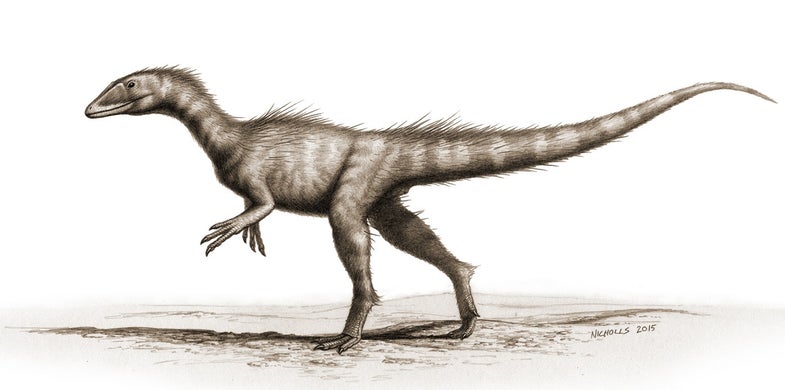Tiny, Ancient T. Rex Relative Found In Wales
Paleontologists psyched to have a new dino fossil to play with

You can find all kinds of things on a beach. Lost sunglasses, loose change, seashells, the fossilized remains of a dinosaur. You know, the usual.
In 2014, fossil hunters found the remains of a dinosaur on a rocky Welsh beach after a storm. They turned the fossil over to National Museum Cardiff, where researchers from the museum and UK universities identified it as a theropod, a relative of Tyrannosaurus rex.
In a paper published this week in PLOS One, researchers announced that further work on the fossil led them to conclude that this dinosaur, named Dracoraptor hanigani, lived 200 million years ago and was one of the earliest dinosaurs of the Jurassic period. It’s also the first Jurassic-era dinosaur skeleton found in the UK.
Why is it exciting that the dinosaur is 200 million years old? There are certainly other, older fossils of dinosaurs out there, dating back into the Triassic period 240 million years ago. But this new dinosaur fossil lived right on the boundary between the Triassic and Jurassic, a line in time that paleontologists are still trying to learn more about.
See, dinosaurs lived during a geologic era called the Mesozoic, which lasted from 250 million years ago to around 65 million years ago, when the dinosaurs went extinct. The Mesozoic is broken into three periods: the Triassic (250 million to 199.6 million years ago), the Jurassic (199.6 million to 145.5 million years ago), and the Cretaceous (145.5 million to 65.5 million years ago). The divisions between these periods are marked by changes in lifeforms and climate, most notably extinctions.
Early dinosaurs evolved in the Triassic, but they didn’t come into their own until the Jurassic, after a huge extinction event that wiped out massive amounts of marine creatures. The cause of the extinction remains unknown, but researchers are always eager to know more about the lifeforms that did manage to survive, or evolved right after an event like this.
Researchers already know a lot about Dracoraptor hanigani. It was a small dinosaur, just 2.3 feet tall, and 6.5 feet long (including its long tail). With bones that were still growing it was possibly a juvenile, and likely was warm-blooded with feathers.
“The Triassic-Jurassic extinction event is often credited for the later success of dinosaurs through the Jurassic and Cretaceous, but previously we knew very little about dinosaurs at the start of this diversification and rise to dominance,” said co-author Steven Vidovic. “Now we have Dracoraptor, a relatively complete two meter long juvenile theropod from the very earliest days of the Jurassic in Wales.”